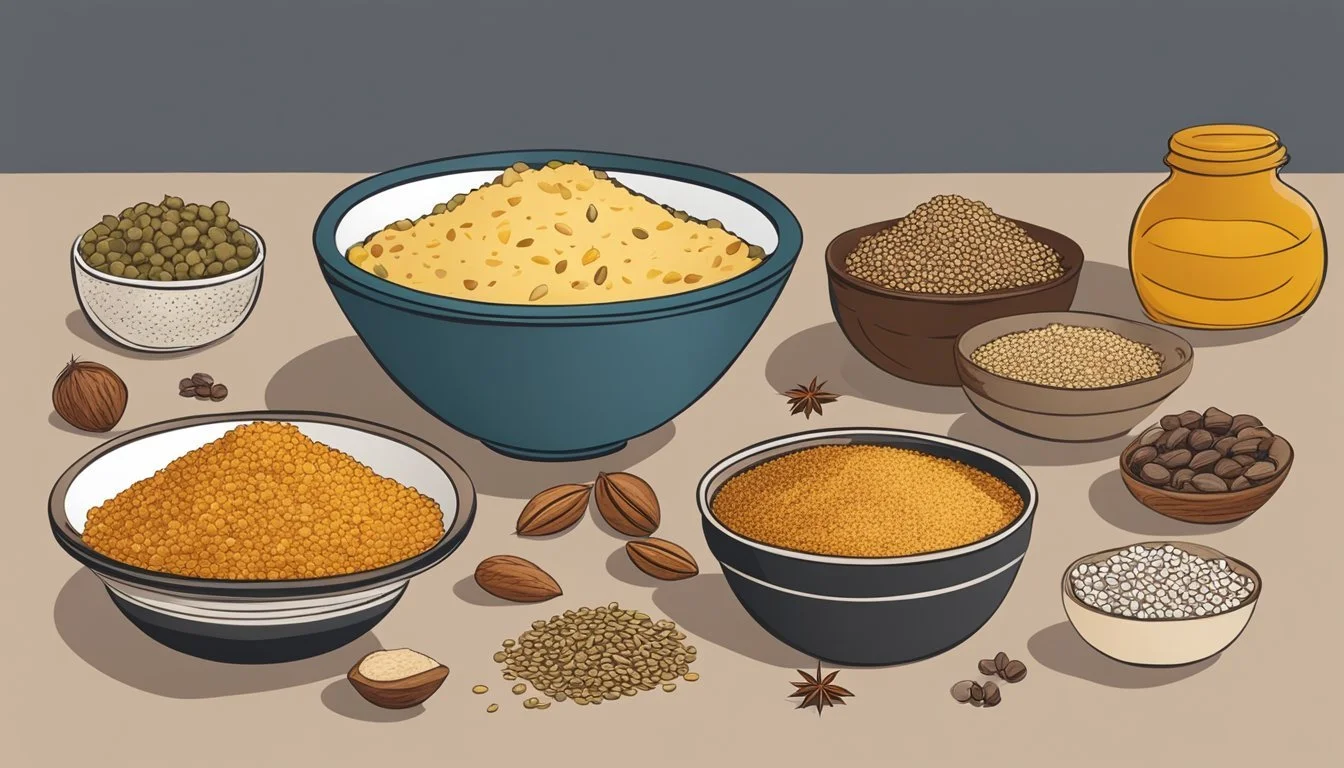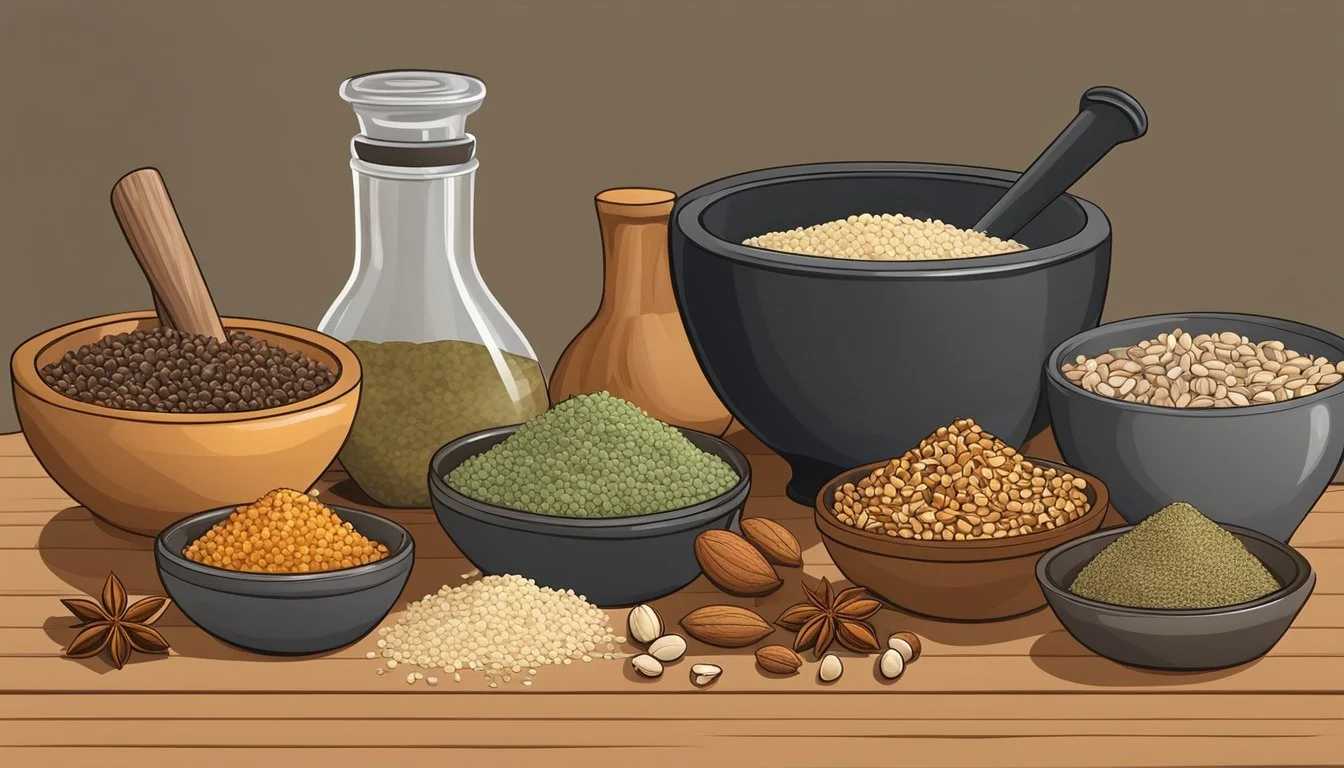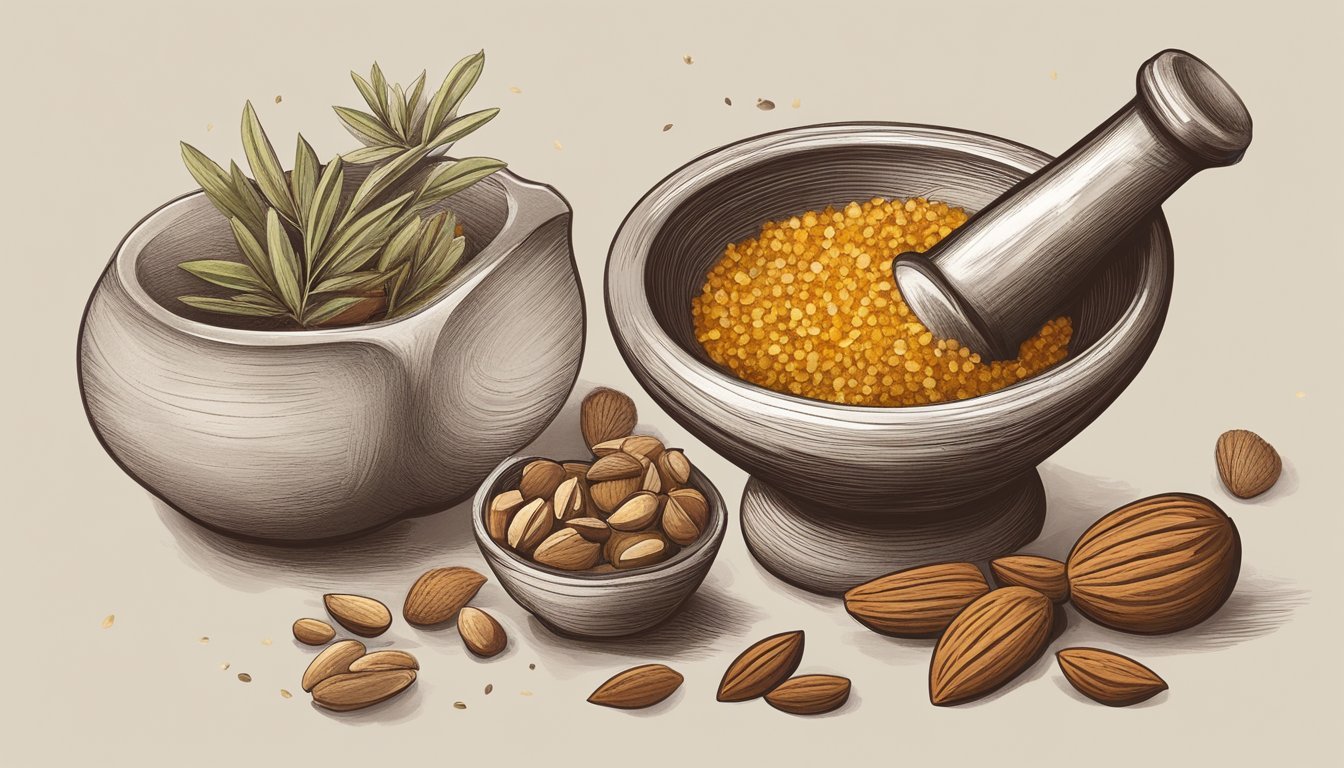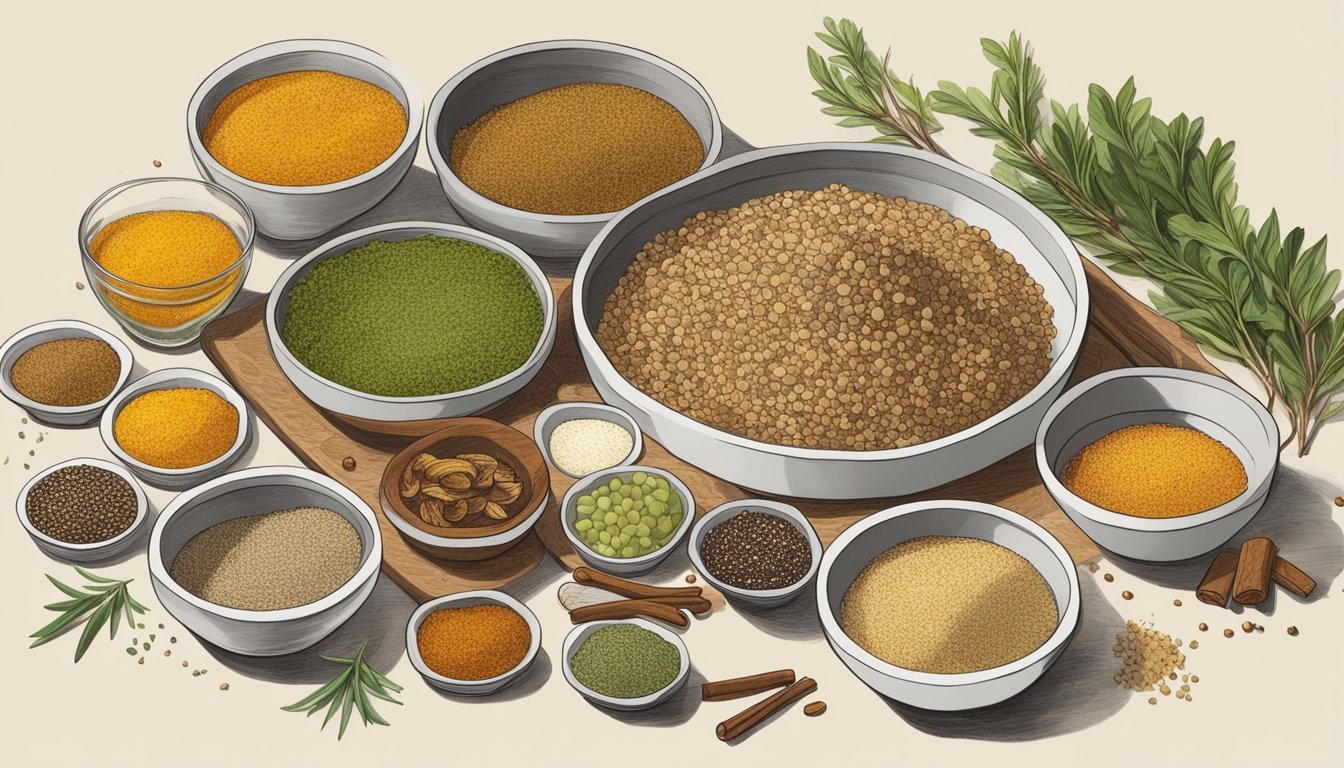Dukkah Substitutes
Best Alternatives for Flavorful Cooking
Dukkah, a flavorful Egyptian condiment, has made a mark in culinary circles with its unique blend of nuts, seeds, and spices. This Middle Eastern spice blend brings a nutty, aromatic presence to dishes, whether sprinkled over vegetables or used as a dip with bread and olive oil. If you can't find dukkah in stores, consider using substitutes such as za'atar, berbere, baharat, ras el hanout, or harissa to maintain the rich, nutty flavors.
For those exploring alternatives, za'atar provides an herbaceous and tangy twist, while berbere and baharat introduce robust and spicy notes to your meals. Ras el hanout, known for its complex blend of spices, and harissa, which offers a spicy, paste-like consistency, are also excellent choices to replicate dukkah's depth.
Experimenting with these other spice blends can offer similar culinary excitement and satisfy the palate, ensuring your dishes remain flavorful and dynamic.
Understanding Dukkah
Dukkah, a traditional Egyptian blend, combines a variety of nuts, seeds, and spices to create a unique and versatile seasoning. It holds cultural significance in the Middle East and serves multiple culinary purposes.
Origins and Cultural Significance
Dukkah originated in Egypt and has been a staple in Middle Eastern cuisine for centuries. Its name derives from the Arabic word "duqqa," which means "to pound," reflecting the preparation method of pounding nuts and spices together.
Traditionally, Dukkah is served as a dip with bread and olive oil. Diners dip bread into olive oil first, then into the Dukkah, allowing the nutty and aromatic mixture to adhere to the oil-coated bread. It is commonly used in meals ranging from simple snacks to more elaborate dishes.
Traditional Composition
Traditional Dukkah typically includes a base of hazelnuts, sesame seeds, and a blend of spices such as cumin and coriander. Each ingredient plays a critical role in the blend's distinct flavor.
Hazelnuts: Provide a rich, nutty foundation.
Sesame Seeds: Add nuttiness and texture.
Cumin and Coriander: Offer warmth and depth.
The mixture often includes salt for balance, further enhancing its complexity. This traditional composition can vary slightly across different regions, but the core ingredients remain consistent. The blend can be used as a dip, seasoning for meats, or sprinkled over vegetables and salads. Dukkah’s versatility and robust flavor make it a beloved condiment in numerous recipes.
Culinary Uses of Dukkah
Dukkah, an Egyptian blend of nuts, herbs, and spices, can be used both as a condiment and incorporated into various recipes to add complex flavors. It enhances meals with its distinct, nutty taste and versatile applications.
Dukkah as a Condiment
Dukkah shines as a condiment, offering a crunchy, savory addition to dishes. It pairs excellently with olive oil as a dip for bread, commonly seen in Middle Eastern cuisine. Simply dip a piece of bread in olive oil and then into the dukkah mixture for a flavorful bite.
It also works well sprinkled over salads and vegetables. The nutty crunch of dukkah can bring a new texture to fresh greens or roasted veggies. Adding it to meat dishes, especially grilled meat, can enhance the flavors, providing a unique twist to traditional marinades and rubs.
Incorporating Dukkah in Recipes
Integrating dukkah into recipes can elevate simple dishes to gourmet experiences. Sprinkle dukkah over salads for an added crunch and rich flavor profile. For meats, dukkah can be used as a dry rub before cooking, imparting its nutty, spicy essence to the dish.
Vegetables also benefit from a light coating of dukkah before roasting, adding a delightful texture and taste. Mixing dukkah into grain-based salads like quinoa or couscous provides a tasty addition, enhancing the dish's complexity.
Additionally, using dukkah as a seasoning for baked dishes such as casseroles or tray bakes offers a subtle, yet impactful flavor. Its combination of nuts, spices, and herbs makes it a versatile ingredient, suitable for a wide range of culinary applications.
Finding the Right Dukkah Substitute
When seeking a dukkah substitute, it's crucial to consider factors such as flavor profiles, texture, and ingredient availability. Suitable substitutes can be found in other spice blends that share similar flavors or uses.
Criteria for Substitution
A good substitute for dukkah should replicate its unique blend of nutty flavor, crunchy texture, and aromatic spices. Since dukkah typically includes a mix of nuts, seeds, and herbs, an ideal substitute should feature similar ingredients.
Flavor: The substitute should have a balanced flavor that combines nutty, savory, and spicy elements. Blends like za'atar or shichimi togarashi often contain sesame seeds that can mimic the nutty taste of dukkah.
Texture: The crunchy texture comes from ground nuts and seeds. Therefore, the substitute must contain coarse ingredients that provide a similar mouthfeel.
Aroma: Spices such as coriander, cumin, and thyme contribute to dukkah’s aromatic qualities. The substitute should also have an inviting aroma with herbal and spicy notes.
Substitutes Based on Ingredient Availability
Selecting a substitute might depend on the ingredients you have on hand. Here are a few options:
Za'atar: A Middle Eastern blend with thyme, oregano, sumac, and sesame seeds. It offers a similar earthy and nutty flavor. Za'atar can be used similarly as a dip or seasoning.
Shichimi Togarashi: This Japanese seven-spice blend includes sesame seeds, chili pepper, and black pepper. It serves as a good substitute due to its spicy, nutty, and aromatic qualities. Use it as a condiment like dukkah.
Baharat: A Middle Eastern spice mix that includes black pepper, coriander, and other spices. Though it lacks the nutty component, it provides a robust flavor profile.
Furikake: A Japanese seasoning containing nori, sesame seeds, and sometimes dried fish. It offers a salty and nutty taste, making it a viable alternative for some dishes.
Choosing the right dukkah substitute relies on balancing flavor, texture, and availability to maintain the essence of your dish.
Popular Dukkah Substitutes
Dukkah, a traditional Egyptian condiment, can be replaced by various mixes and blends that offer similar nutty and earthy flavors. Below are the top substitutes categorized into seed and nut mixes, herb-infused alternatives, and international spice blends.
Seed and Nut Mixes
Za'atar: This Middle Eastern blend combines thyme, oregano, sumac, and sesame seeds. It offers a similar texture and nutty flavor to dukkah. Almonds and pistachios can also be added to the mix for extra crunch and depth of flavor.
Furikake: A Japanese seasoning that typically includes sesame seeds, seaweed, and fish flakes. It replicates the nuttiness and adds a hint of umami. It’s often sprinkled on rice but can also be used on vegetables or meats.
Tsire: Known as suya spice, it is a West African blend primarily made from ground peanuts, ginger, and chili peppers. It can mimic the nutty and spicy profile of dukkah while adding a slightly different flavor twist.
Herb-Infused Alternatives
Za'atar: As noted, za'atar is a versatile option that serves well as a dukkah substitute. The herbal notes from thyme and oregano combined with the tangy taste of sumac provide a balanced and aromatic alternative.
Herb Mixes with Nuts: Combining herbs like fennel, thyme, and oregano with crushed almonds or pistachios can create a homemade blend. This delivers fresh, aromatic flavors with the added nuttiness that dukkah is famous for.
International Spice Blends
Ras el Hanout: A North African spice blend that includes both sweet and savory spices such as cinnamon, coriander, and cloves. While it doesn't contain nuts, it can be mixed with crushed nuts to better resemble dukkah's texture and complexity.
Cajun Spice Blend: This mix typically contains paprika, garlic powder, and black pepper. Adding roasted peanuts or almonds can give it the necessary crunch and make it a satisfactory substitute for dukkah.
By using these popular alternatives, you can add unique flavors and textures to your dishes, providing a similar experience to using traditional dukkah.
Homemade Dukkah Recipe Tips
Creating homemade dukkah allows for control over texture and flavor. This involves achieving a consistent blend and balancing spices to enhance both aroma and taste.
Getting the Right Consistency
Achieving the desired texture for dukkah is crucial. The mix should be slightly coarse rather than powdery, providing a pleasant crunch. Toasted sesame seeds, nuts, and spices are typical ingredients.
Using a food processor helps in breaking down these components. However, avoid over-processing to prevent a fine powder. After processing, combine by hand to ensure the ingredients are evenly mixed.
To further enhance the texture, toast the seeds and nuts beforehand. This brings out a more robust flavor.
Balancing Flavors and Aromas
Balancing the spices in the dukkah mix ensures a harmonious flavor profile. Traditional dukkah often includes coriander, cumin, fennel, salt, and pepper. Each spice should complement without overpowering.
Toasted seeds and spices add depth, while adding a bit of olive oil to the mix before serving can enrich the flavor. Adjust salt levels to taste, as it amplifies the other spices.
Consider adding lemon zest for a hint of citrus, which can brighten the overall aroma. Attention to the balance of each ingredient ensures that the final product tantalizes both taste and smell.
Creative Ways to Use Dukkah and Its Substitutes
Dukkah and its substitutes, such as Za’atar, Berbere, Baharat, Ras el Hanout, and Harissa, offer versatile and flavorful options for various culinary uses. These spice blends can enhance main dishes, side dishes, snacks, and even be incorporated into baking.
Enhancing Main Dishes
Dukkah and its substitutes can elevate main dishes in many ways. Used as a rub for meats like lamb, chicken, or fish, these spices add a unique aroma and taste. Sprinkling dukkah over roasted vegetables like carrots, potatoes, or bell peppers can turn an ordinary dish into an extraordinary one.
You can also mix these spices into marinades for grilled or baked recipes, providing a robust flavor profile. For instance, coating lamb chops in dukkah before grilling gives them a delightful crunchy crust and an earthy, nutty taste.
Fish fillets benefit greatly from a light dukkah crust, adding an extra layer of texture and flavor without overpowering the delicate taste.
Elevating Side Dishes and Snacks
Side dishes and snacks can be significantly enriched with dukkah and its substitutes. Salads sprinkled with these spices get an added crunch and flavor depth, making them more exciting. Simply toss some dukkah over a simple olive oil-dressed salad to transform it.
For bread lovers, dipping flatbread or toast in olive oil and then in dukkah is a delightful snack or starter. It’s also a great addition to hummus or other dips, injecting an exotic twist.
Roasted nuts and seeds coated with these spice blends turn into a savory snack, perfect for parties. Even a plain yogurt dip can be elevated with a sprinkle of dukkah, providing a complex flavor profile with minimal effort.
Dukkah in Baking
Bakers can incorporate dukkah and its substitutes into their recipes to add an unexpected yet welcome twist. Breads and flatbreads sprinkled with dukkah before baking get a wonderful crust and an aromatic, nutty flavor.
In sweet bakes, using dukkah with nuts like hazelnuts or almonds can add an interesting contrast. For example, sprinkle some dukkah on top of biscotti dough before baking. This adds a savory note to the usually sweet treat.
Crackers and breadsticks can also benefit from a dukkah topping, providing a flavorful crunch that pairs well with cheeses and other appetizers.







